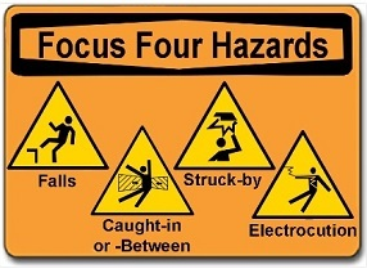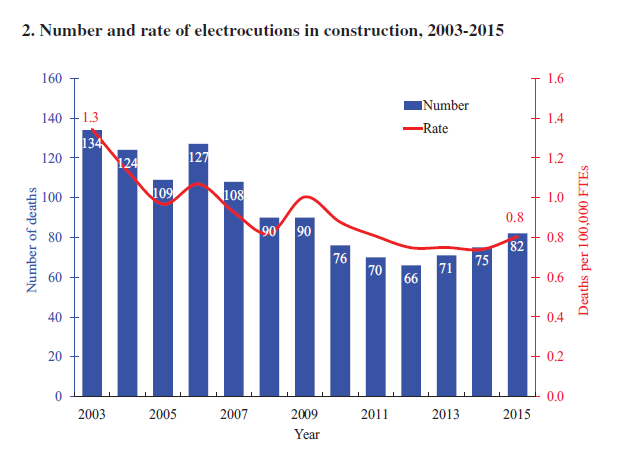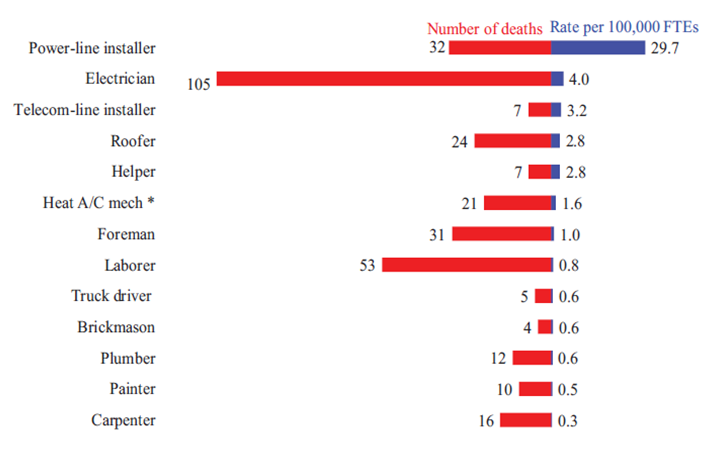Preventing Electrocution of Construction Contract Workers
Posted on byThe National Fire Protection Association (NFPA) recently released a report based upon U.S. Bureau of Labor Statistics, Census of Fatal Occupational Injuries (CFOI) data showing that 77% of the 325 contract worker electrocutions that occurred from 2012-2016 involved workers employed in the construction industry (NFPA 2018).
Nearly 60% of the electrocutions were caused by direct contact with electricity. Construction workers account for a large portion of electrical injuries in the US each year. In 2015, for example, 61% of all US workplace electrocutions occurred in construction (82 of 134 total deaths), but these data do not tell the whole story. There is more to be learned from the data.
Construction and the Focus Four Hazards

In another analysis, researchers found construction workers are approximately four times more likely to be electrocuted than workers in all other industries combined (Campbell and Dini 2016). OSHA has included electrocutions as part of the Focus Four Hazards for construction because of the persistence and significance of this hazard.
The Focus Four Hazards represent the causes of nearly 60% of all construction fatalities each year and include: Falls (from elevation and on the same level), struck-by incidents (vehicles, flying objects, etc.), caught-in and between (trench collapse, rollovers etc.), and electrocutions (Taylor 2015). Falls from elevation (typically ladders, roofs, and scaffolds) are the most common cause of construction fatalities, representing nearly 40% of all such incidents. The other three hazards each represent approximately 5-10 percent of the total annual construction fatalities (OSHA 2019).
OSHA also conducts thousands of inspections of construction sites each year. Often the top ten most frequently cited OSHA violations involve electrical safety issues including wiring methods, lockout/tagout, and general electrical requirements (Zoubek 2016, MSDSOnline 2019).
According to CPWR – The Center for Construction Research and Training, the total number and rate of electrocutions in construction fell between 2003 and 2015 (CPWR 2017). In 2003, there were 134 electrocutions or 1.3 electrocution fatalities per 100,000 full-time workers. In 2015, there were 82 electrocutions or 0.8 electrocution fatalities per 100,000 full-time workers. Although this represents approximately a 40% decrease in the electrocution rate and a corresponding decline in total numbers of fatalities during that time, the decline could be related to the economic recession during that period in which fewer numbers of workers were employed. However, the numbers are still much higher than those in many other industries (Zhao, Thabet et al. 2012). In fact, the number of electrocutions in construction each year is comparable to the number of electrocutions each year in all other industries combined (Zhao, Thabet et al. 2012).

Based upon the occupation, 105 electricians died of electrocution from 2011 to 2015, more than in any other construction occupation (Figure 3). However, the risk of electrocution was highest for power-line installers, who had a rate of 29.7 deaths per 100,000 full time workers, or approximately forty times that of all construction occupations on average (0.8 deaths per 100,000 full time workers). In addition to power-line installers and electricians other construction trades with elevated rates of electrocution include: roofers, HVAC mechanics, and laborers (CPWR 2017).

Common Causes of Electrical Fatalities
More than half of the electrocutions of electrical workers were caused by direct (from power source) or indirect contact with live electrical equipment and wiring (including light fixtures, circuit breakers, control panels, junction boxes, and transformers) (McCann, Hunting et al. 2003, Janicak 2008). Many of these violations are related to the use of temporary power during construction and renovation (Wheeler 2016). The National Electrical Contractors Association (NECA) has developed a consensus standard on this topic. The standard addresses how to conduct proper planning and avoid common OSHA violations related to planning, use of receptacles, and temporary lighting among other topics (NECA 2016). For non-electrical workers, the main cause of electrocution was contact with overhead or underground power lines. These deaths were the result of failure to de-energize or protect the power lines and failure to maintain minimum clearance distances from power lines. Lastly, another common cause of electrocution is the improper use or care of extension cords.
Many of the contractors who experienced fatal electrical injuries were not trained electrical specialists, including construction laborers, roofers, service workers, and other occupations. It is important to realize that electrical safety training is needed by electrical specialists and other construction trades that may be exposed. Additionally, it is important that electrical safety training and related materials be delivered in the native language of the worker to address the significant number of Hispanic workers (nearly 30% of the total) in the US construction industry (Dong, Wang et al. 2010, CPWR 2018).
Contractor Safety
On most construction sites, multiple contractors (a general contractor and multiple subcontractors) work collaboratively to finish the project. Use of contractors can reduce payroll expenses and increase flexibility on the job. Contractors have more autonomy in the work they perform than regular employees, but often have fewer benefits and less protection than a regular employee.
Use of contractors has resulted in increased risks of accidents and deaths, and nearly 50% of annual construction fatalities (2013 – 2017) occurred to contractors (BLS 2018) (NFPA 2018). General contractors with a good safety culture mentor their subcontractors on best practices for safety. This practice of mentorship is more common among larger contractors (Dodge Data 2018). OSHA and NIOSH guidance for temporary workers indicates that host employers and contractors are considered joint employers who are jointly responsible for safety and health, with their obligations varying based on working conditions or as clarified by contract.
Construction projects often entail strong pressures to complete projects on-time and under-budget, which for general contractors and subcontractors can cause tight deadlines. When schedules are threatened, workers may be pressured to increase their pace or work longer hours, which can adversely impact safety. Sometimes these pressures can result in decisions to compromise safety by not de-energerizing electrical circuits to avoid slowing production in other areas.
Prevention
Electrocutions are preventable but still consistently rank as a leading cause of fatalities in the construction industry. This hazard is even more pronounced among construction contractors. General contractors should be selected based on reliability and safety considerations as well as their use of best practices. General contractors should provide mentoring to their subcontractors. It is also important that health and safety responsibilities be assigned in the contract and to never compromise safety for production. Contractors should establish reasonable expectations for work completion and not overpromise. CPWR has developed training materials for construction foreman that can help.
Various approaches are needed to reduce or eliminate electrocutions, but in general, it is important to control contact with electrical voltages and the currents they can cause. Safe work practices such as using caution near energized lines, de-energizing equipment before inspection and repair, properly maintaining tools and equipment, and using appropriate PPE are all important. Contract workers should fully understand the extent of the electrocution hazard and how to prevent it. Young and apprentice electrical trades workers should receive significant training in electrical safety. Specific steps to maximize jobsite safety include the following:
- Comply with and follow all OSHA (29 CFR 1926 subpart K) and NFPA electrical safety standards (NFPA 70E) and train workers on the Focus Four Hazards.
- When using temporary electric power on construction and renovation sites, be sure to properly plan for the system and utilize ground-fault circuit interrupters (GFCIs). Good guidance for temporary power is available from NECA and addresses responsibilities, planning, load estimates and other key topics (NECA 2016). Many components of the final electrical installation could be part of temporary power when well planned.
- Know the location of overhead and underground power lines to avoid accidental contact. Contact utility companies to de-energize or maintain a safe distance of ten feet or more from overhead power lines.
- Use lock-out/tag-out practices to ensure that circuits are de-energized before servicing equipment.
- Ensure all electrical equipment is properly grounded or double insulated.
- Inspect tools prior to use and check extension and power cords for wear and tear. If damaged remove the equipment from service.
- Disconnect the plug on any power tool or machinery before inspecting or repairing.
- Keep metal objects away from live electrical circuits/parts.
More information from NIOSH related to electrical safety is available here.
We would like to hear from you. How has your company worked to prevent electrocutions at construction sites? Please provide input in the comment section below.
Scott Earnest, PhD, PE, CSP, is the Deputy Director for the NIOSH Office of Construction Safety and Health, Coordinator for the Construction Sector.
CAPT Alan Echt, DrPH, CIH, is a Senior Industrial Hygienist in the NIOSH Office of Construction Safety and Health.
CDR Elizabeth Garza, MPH, CPH, is Assistant Coordinator for the Construction Sector in the NIOSH Office of Construction Safety and Health.
References
BLS (2018). Census of Fatal Occupational Injuries (CFOI). (2007-2018). Numerous tables and data profiles. Bureau of Labor Statistics (BLS)
Campbell, R. B. and D. A. Dini (2016). Review of Select OSHA Investigations of Workplace Electrical Incidents. Occupational Injuries From Electrical Shock and Arc Flash Events, Springer: 55-67.
CPWR (2017). Quarterly Data Report: Electrocutions and Prevention in the Construction Industry. Silver Spring, MD, The Center for Construction Research and Training.
CPWR (2018). The Construction Chart Book: The US construction industry and its workers. Silver Spring, MD, Cpwr-The Center for Construction Research and Training.
Dodge Data (2018). Contractor use of safety best practices.
Dong, X. S., X. Wang, C. Daw and C. D. Center (2010). “Fatal and nonfatal injuries among Hispanic construction workers.” CPWR Data Brief 2(2): 1-19.
Janicak, C. A. (2008). “Occupational fatalities due to electrocutions in the construction industry.” Journal of Safety Research 39(6): 617-621.
McCann, M., K. L. Hunting, J. Murawski, R. Chowdhury and L. Welch (2003). “Causes of electrical deaths and injuries among construction workers.” American journal of industrial medicine 43(4): 398-406.
MSDSOnline. (2019). “OSHA’s Top Ten Most Cited Violations of 2018.” Retrieved 01, 23, 2019.
NECA (2016). Standard for Installing and Maintaining Temporary Electric Power at Construction Sites. Bethesda, MD, National Electrical Contractors Association. 200-2016.
NFPA (2018). Fatal Electrical Injuries of Contract Workers. R. Campbell. Quincy, MA, National Fire Protection Association.
OSHA. (2019). “Commonly Used Statistics.” Retrieved 02/04/2019, from https://www.osha.gov/oshstats/commonstats.html.
Taylor, E. L. (2015). “Safety benefits of mandatory OSHA 10 h training.” Safety Science 77: 66-71.
Wheeler, W. (2016). “Temporary Electrical Power, Keeping it Safe!” Occupational Health and Safety Sept.
Zhao, D., W. Thabet, A. McCoy and B. Kleiner (2012). Managing electrocution hazards in the US construction industry using VR simulation and cloud technology. eWork and eBusiness in Architecture, Engineering and Construction-Proceedings of the European Conference on Product and Process Modelling.
Zoubek, P. A. (2016). Electrical Hazard Identification & Mitigation: Addressing OSHA’s Top Ten. ASSE Professional Development Conference and Exposition, American Society of Safety Engineers.
Posted on by

